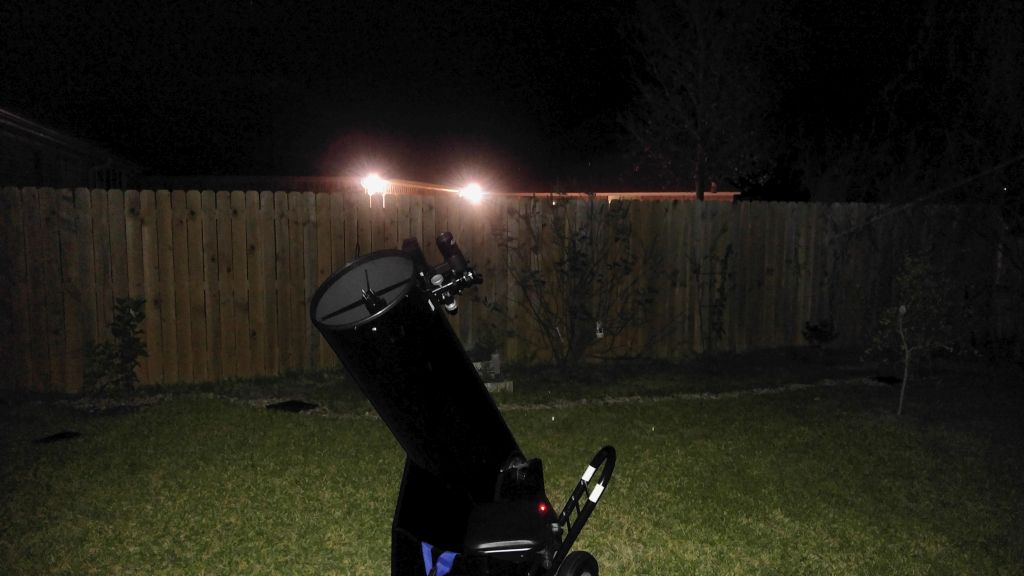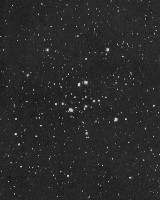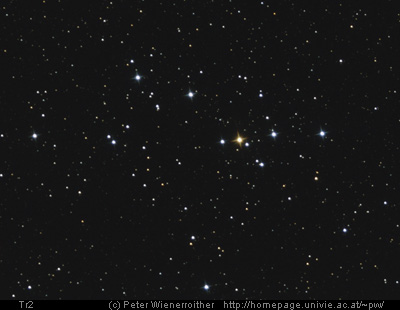
| Observer: | Tom Campbell |
| Location: | College Station, Texas (Long: 96°17'W Lat: 30°37'N) |
| Telescope: | Zhumell 12" f/5 Dobsonian |
| Eyepieces: | Explore Scientific 18mm (83x) Explore Scientific 11mm (136x) |
| Lenses: | Celestron Luminos Barlow (2.5x) |
| Weather: | The sky was clear and transparent. Temperature was in the 60s (F) with a slight breeze. |
The weather forecast has been for mostly sunny days followed by mostly cloudy nights for the next week or so. As I was outside this evening, I was surprised to see it clearing off. I did a quick check on a couple of my weather apps and it seemed like I was in luck ... the clouds were supposed to mostly stay away until after midnight.
I grabbed my scope and set it up in the back yard and let it "cool down" while I finished my outdoor chores and had a bite of supper. When I stepped back outside to observe, I was greeted with a nasty surprise: one of my neighbors had turned on his back yard security lights. They were mounted just high enough that they shone over the top of my privacy fence.

I was hoping to try for a few galaxies tonight, but there was no way I could compete with that kind of light pollution. I looked for the darkest part of the sky I could find. Fomalhaut was shining brightly down in the southern muck, but it was far enough above the houses that it made a tempting target.
I looked at my star map and saw a double star not too far away from Fomalhaut, in the constellation of Piscis Austrinus, the Southern Fish. This would be my first-ever venture to this constellation. In Kansas, it was way too low in the sky. Even this far south in Texas, it's over the house tops, but still in the thick murky atmosphere. I wasn't able to see any of its stars naked eye, so had to starhop from Fomalhaut using my finder scope.
| γ PsA | Piscis Austrinus | Double Star | 7:45pm CST |
This double was easy to find, just south of Fomalhaut. With the 18mm (83X), it looked like a single star. However, with a barlowed 11mm (341X), the companion was very close, but obvious. The primary was bright white and the companion was yellowish-white and much fainter. Very nice! |
|||
I then spent quite a bit of time trying to locate NGC 288, a globular cluster in the same constellation. I think I found the right spot for it, but wasn't able to see it through the murky haze. Time to try for something a bit higher up.
| γ And (Almach) | Andromeda | Double Star | 8:10pm CST |
With the 18mm eyepiece (83X) it was beautiful, showing a bright yellow primary and a medium blue companion, which was a magnitude or two fainter. |
|||
| M 34 (Spiral Cluster) | Perseus | Open Cluster | 8:15pm CST |
 |
This wide open cluster fit nicely into the field of my 18mm eyepiece. Maybe three dozen stars were visible in what reminds me of a pinwheel shape. Many of the stars near the middle formed pairs. It looked nice but it would be more impressive if it were a bit more compact. |
||
I looked up and noticed something had changed. The security lights were finally turned off! Feeling a little excited, I decided to try for a galaxy. Halfway between Almach and M34 was NGC 891, a galaxy that has thus far eluded me. Since I was in the area, I thought I'd try again. I found the exact star field and took a look. Nothing. Still too faint to pick out of the sky glow. Rats! Back to the brighter objects on my list.
Something else in the sky garnered my attention. A cloud bank moving in. "You're three hours early! That's not fair," I muttered under my breath. The wind was picking up, too. I better hurry and try to get in another observation or two before the sky was completely covered.
| η Per | Perseus | Double Star | 8:50pm CST |
This was a nice double, easily found. It had a wide separation, but the nicest view was with my 11mm (136X). The primary was a bright yellow and the companion was a magnitude or so fainter and was medium blue. |
|||
| Trumpler 2 | Perseus | Open Cluster | 8:55pm CST |
 |
This was a long and narrow open cluster. I could detect a couple dozen stars. One of the stars near the center was bright yellow. |
||
| IC 2003 | Perseus | Planetary Nebula | 9:05pm CST |
 |
This planetary is surrounded by brighter stars. Using my barlowed 11mm (341X), it became pretty obvious that it was a planetary rather than a fainter star. It was fairly bright but somewhat small and roundish, looking like a defocused star. |
||
The wind was picking up even more now, and the clouds were taking over the last few constellations still visible. Time to call it a night. But I can't complain. I wasn't even planning on getting to observe at all this week. Ninety minutes under the night sky felt good.